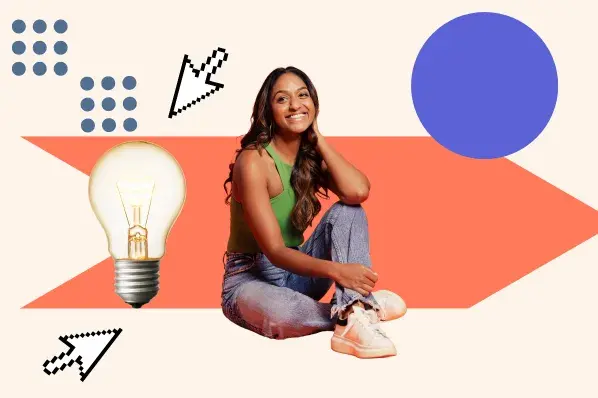In this post, we’ll go over what omnichannel means and how you can use omnichannel strategies to build an exceptional customer experience. I’ve also compiled examples of brands who are leading the pack in creating omnichannel experiences.
Table of Contents
- Omnichannel
- What is the omnichannel experience?
- Omnichannel Marketing
- Omnichannel Marketing Examples
- Omnichannel Benefits
- Where Can Your Business Use an Omnichannel Strategy?
- How Omnichannel Works
- How to Build an Omnichannel Marketing Campaign
- How Is AI Used in Omnichannel Customer Experience?
- Omnichannel Marketing Platforms
- Omnichannel Retail
Omnichannel
Omnichannel is an integrated approach allowing companies to interact with current and prospective customers across channels, platforms, and devices.
Instead of only offering support on my desktop website, for example, I'd also offer support through Facebook Messenger, live chat, email, and phone.
Omnichannel Benefits
Adopting an omnichannel approach in your marketing, sales, and service strategies has plenty of benefits. The advantages include:
Greater Reach
With an omnichannel retail, marketing, or service strategy in place, you’ll be reaching your customers where they are and in more places.
They no longer have to search and search to find you because, regardless of the channel they’re on, your team or your products are only a click, an email, a direct message, or a phone call away.
Plus, when you’re on more channels, opportunities for exposure and building brand awareness with new audiences are even higher.
Seamless Customer Experience
Omnichannel lets customers interact with your company across multiple different channels, but still have the same consistent experience. It also allows them to choose their favorite channel for getting service so they don’t have to, say, get off Instagram and pick up the phone. They can just find your business profile and send you a DM — a seamless experience within one single app.
A frictionless process leaves customers more satisfied, and satisfied customers are more likely to become loyal customers.
Boosted Customer Satisfaction and Loyalty
Your customers will be happier in the long term if they feel they have several methods to reach your customer service and sales teams, or if they can purchase your product easily regardless of their device or preferred platform.
For example, the number of consumers shopping on social media has grown significantly in the past few years, and, in turn, so has the number of social media users who have sent a DM for customer service (27% increase between 2022 and 2023, to be exact).
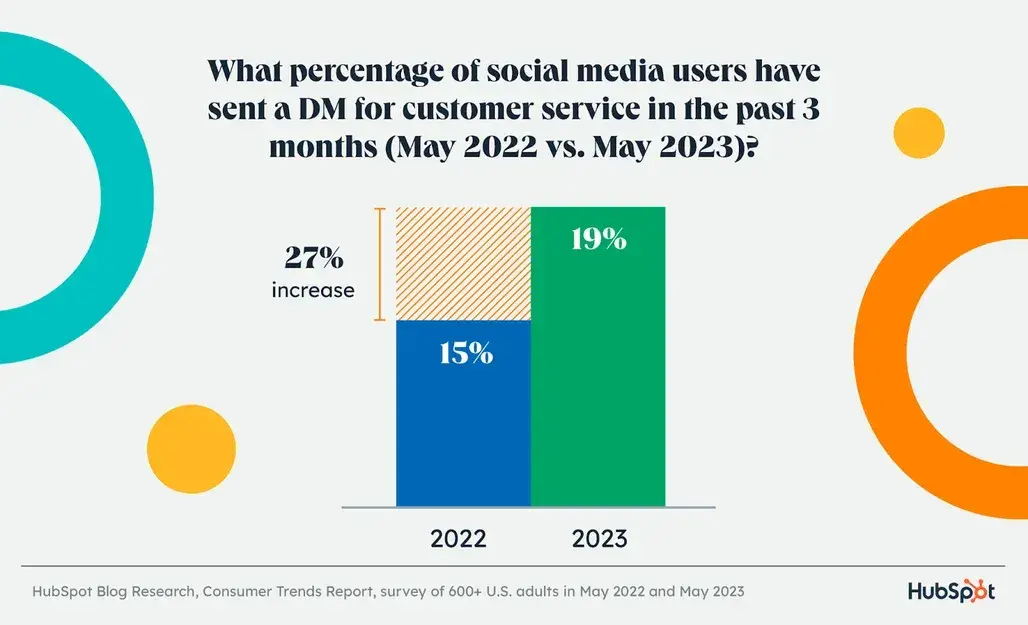
Customer satisfaction is the key to reducing customer churn and keeping them returning to you for their needs, and satisfied customers become loyal customers.
Faster Issue Resolution
Customers want fast service. They expect quick resolutions, but service teams sometimes struggle to provide them.
An omnichannel customer service solution is the fix to this problem. You have the chance to meet customers where they are, exactly when they’re looking for support, lowering your average time to resolution and setting customers up for success.
If you have dedicated reps for each of the channels you offer, you’re lowering resolution time even more because there is someone ready to help as soon as a customer reaches out.
You can also deploy self-serve knowledge bases and AI-powered chatbots to help customers solve common issues on their own. This reduces agent strain and operational costs and simultaneously improves customer satisfaction.
Increased Profits
If and when your prospects are ready to buy, they’ll find it much easier to make a purchase if they can find your product on multiple platforms and channels. Offering a multi-channel retail experience also ensures it’s easier for them to purchase from you again or renew their subscriptions, securing recurring revenue.
As you can see, creating an omnichannel experience for your customers is critical for your business's success. That said, what is the omnichannel experience?
What is the omnichannel experience?
The omnichannel experience is marketing, selling, and serving customers on all channels to create an integrated and cohesive customer experience no matter how or where a customer reaches out. The experience should be the same for customers regardless of the platform or method they choose to use.
Your customers can shop online from a desktop or mobile device, by telephone, or in a brick and mortar store and the experience should be equally seamless.
It's important here to distinguish an omnichannel experience from a multi-channel experience. Essentially, it comes down to the depth of the integration between the channels and platforms your business is on.
Omnichannel vs. Multi-Channel
In a multi-channel environment, a user has access to a variety of communication options that aren’t necessarily synchronized or connected. However, during an omnichannel experience, there are not only multiple channels. Instead, the channels are connected, so you can move between them seamlessly.
The difference between omnichannel and multi-channel experiences comes down to two distinctions:
- All omnichannel experiences use multiple channels, but not all multi-channel experiences are omnichannel. You can have amazing mobile marketing, engaging social media campaigns, and a well-designed website, but if they don't work together, they don’t create an omnichannel customer experience.
- Omnichannel experiences account for all devices, channels, and platforms, whereas a multi-channel strategy might include two or three.
Most businesses invest in the multi-channel experience today. They’ll have a website, blog, Facebook, and Twitter and use each platform to engage with customers. However, in most cases, the customer still lacks a seamless experience and consistent messaging across each of these channels.
“It doesn’t matter how many channels you have. Once you get past one, you are in the world of multi-channel,” explained Customer Experience Speaker Shep Hyken. “The problem is that while multi-channel gives you options to choose your favorite method of communication. If you switch from one channel to the next, you typically have to start the conversation over.”
An omnichannel experience accounts for each platform and device a customer will use to interact with the company — and also creates an equally efficient and positive experience across all platforms.
Creating an omnichannel experience is especially important in retail because whether or not you have an omnichannel retail strategy can determine how much you sell.
Omnichannel Marketing
Omnichannel marketing is a method where businesses promote their products and services across all channels, devices, and platforms using unified messaging, cohesive visuals, and consistent collateral. Omnichannel marketing ensures you reach customers where they are with a relevant and on-brand offer.
By uniting the strengths of each communication channel, marketing teams can use omnichannel marketing to deliver a more effective brand message. They can also reach target buyers at the right time, increasing the chances of converting them into a lead.
Omnichannel marketing uses the customers‘ perspectives and interests to optimize the consistency of the company’s marketing messages. For instance, on Instagram and Facebook, you might only target users with a certain interest and create collateral that appeals to them specifically.
Omnichannel marketing shouldn’t be done on a whim, though. I recommend creating an organized omnichannel marketing strategy to ensure you always deliver the right content to your prospective buyers at just the right time.
Below, I’ll go over how you can start implementing your own omnichannel experience and highlight examples from brands that are already making moves to offer these experiences.
Where Can Your Business Use an Omnichannel Strategy?
Wondering where to leverage omnichannel for best results? The answer is … everywhere! An omnichannel strategy works best when integrated throughout your organization and linked through a central tool to support the customer journey from end to end.
1. Marketing
The first place you can leverage omnichannel is in your marketing campaigns. Adtech makes it possible for brands to use data to send smarter, personalized ads across devices. For instance, if someone visits your online store, you can send them a Facebook ad re-targeting the product they looked at. You can also send a personalized email with a discount or a nudge to complete their purchase.
2. Sales
As prospects move down the funnel, the importance of omnichannel continues. It takes an average of eight touchpoints to book an initial meeting with a prospect, according to RAIN Group research. With an integrated CRM like HubSpot Sales Hub, a sales rep can send emails, SMS, or make a phone call all through a single portal, adding notes which leave context for the next conversation.
3. Service
Customers want to ask for help using the channel that’s most familiar— whether that’s chat, voice, email, or social messaging like WhatsApp. Omnichannel service facilitates communication between customers and company reps in one place with the help of a Service Hub.
I love how omnichannel strategies work for all types of companies, from small to enterprise. Omnichannel helps a small business consolidate multiple functions that one employee might manage and helps a large business personalize and improve a complex customer journey. Let’s look at how this might work in practice.
How Omnichannel Works
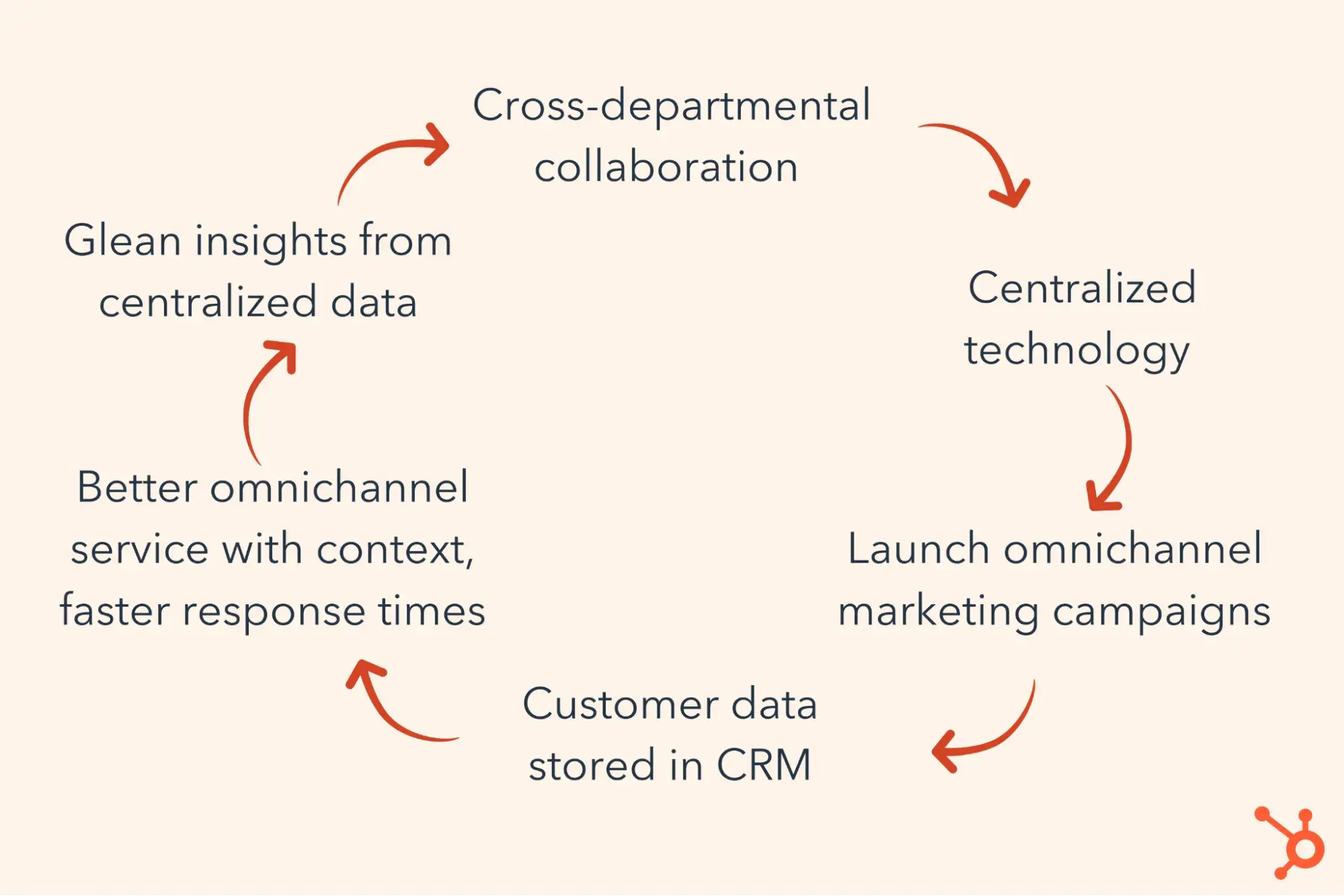
For omnichannel to function across the company journey, companies need to break down siloes and cross-collaborate to reach a common goal. This requires strong leadership, teamwork, and change management, but it also hinges on technology. Here are the three tech platforms you need to make a cross-channel strategy work:
1. CRM
A CRM, or customer relationship management system, stores all of your customer data in one place. This lets sales reps or service agents quickly contextualize and personalize their responses when a customer reaches out for support. The data also powers your marketing campaigns and gives you critical insights for improvement.
Look for a CRM with a Marketing Hub that lets your team chat and email with customers all in one place.
2. Demand-Side Platform DSP
A DSP allows marketers to purchase programmatic advertising through real-time bidding. Essentially, this platform automates the media-buying process across channels. You simply upload your creative, set parameters for the audience you want to reach, and watch the software work its magic. DSPs can place mobile ads, banner ads, and video ads on Google, Facebook, Instagram, and websites and apps across the web.
3. Ticketing Software
Ticketing software streamlines customer interactions across channels, allowing customers to transition smoothly between channels without repeating information. A ticketing system lets service agents track and resolve issues across channels and glean insights from the data gathered.
How to Build an Omnichannel Marketing Campaign
An omnichannel marketing strategy is consistent messaging, visuals, and positioning statements across all channels, platforms, and devices. It's a seamless brand experience for customers and ensures that your brand is presented the same way from platform to platform.
Keep in mind that omnichannel marketing campaigns positively impact your sales and service departments, too. You’re showing customers that you’re on all of the channels and platforms they’re on, so they’ll know to expect a similar experience, whether they’re shopping or getting support.
1. Start with the basics: Your website and social media channels.
Creating an omnichannel experience is a slow process. You don’t need to be everywhere all at once; you’ll get there in time. Start with your website and social media channels and nail those down before moving on to other platforms. Ensure that you’re posting consistently and engaging with users who reach out to you via those channels.
If you consistently engage with users on Instagram but don’t answer on Facebook, they’ll notice. Focusing on one and neglecting the other will make your brand look inconsistent and unprofessional.
A shared inbox can be useful for this, putting your social messages, emails, and chat threads into one place. Some social management tools, like the one in Marketing Hub, will even connect your social campaigns to your CRM so you can keep track of visits and leads.
2. Seek to solve for the customer every step of the way.
While I understand that it’s important to diversify your presence, adding new channels to your omnichannel strategy without considering your customers isn’t worth it.
Why? It’s not just for your company to get more visibility or for you to make more sales. Those are tangible benefits to establishing a strategy, yes, but you mainly want to make sure your customers have an easy and issue-free experience.
When you add a new channel to your omnichannel strategy, do it to solve for the customer along every step of the way.
3. Use the same messaging across channels, but beware of using boilerplate content.
To create a consistent experience, use the same messaging across channels. For example, if I’m running an ad on multiple social platforms, I can vary the ad format for what performs best on each channel, but my messaging needs to be the same to maintain the overall purpose of my campaign. I want someone to be able to see my product announcement email and understand that it’s the same product campaign they just saw a video for on TikTok.
A slight variation in wording across channels can also be important, as you can be penalized by search engines and social media platforms for duplicate, boilerplate content. Instead of always using the same phrases, create a consistent brand voice that allows you to mix it up without looking inconsistent.
4. Give customers a device- and platform-appropriate CTA.
Every time you engage with customers on certain channels — whether it’s on an ad, an organic post, a private message, a phone call, or an email — you should end the engagement with a CTA. That CTA should, of course, be device- and platform-appropriate.
For instance, I would have my social media ad lead to my mobile website, not the desktop version. I’d close my email with a link to schedule a meeting, not with a link that triggers an automatic download because my customer might not be using a mobile device to check their email.
Ensure that the CTA doesn’t throw off the customer and only extends the seamless experience you’ve already provided.
Pro tip: If you use HubSpot's free CMS, you can try out different CTA buttons, pop-ups, and sticky CTAs. You can also A/B test variations, so that you can be sure you're creating an effective omnichannel experience.
5. Create an app if needed.
I have to point out that this step may not be relevant to you, depending on your industry and product.
However, mobile apps bring various benefits to customers and businesses, regardless of their size. For example,
- Ease of access. Many people have smartphones, so if you have an app, customers can easily access it from a device they usually don’t let leave their sights.
- Communication opportunities. With an app, you have the opposition to send push notifications to users to notify them of important events, whether that be flash sales or important product information.
If you’re a small company, you can hire a freelance developer to create an app. Just be sure to have a legitimate reason for offering an app and to think through every functionality. Read this article to learn how to make an app and the steps to do it successfully.
Looking for some inspiration? Read on to find some high-quality examples of omnichannel experiences.
How Is AI Used in Omnichannel Customer Experience?
The AI revolution is already here. 75% of companies currently use AI in customer service, and 71% plan to increase AI investment in 2024.
While it’s still new, companies are already reaping the benefits. In our State of Service report, 92% of CRM leaders said AI has improved their customer service response times, and 77% believe AI will handle most ticket resolutions by 2025.
1. Self-service models
One of the age-old challenges of customer service is time. Many businesses can’t offer 27/4 agent support or keep up with a surge in support requests. Instead, customers run into the dreaded wait queue as they wait for help.
Self-service models, where customers can get the help they need without a human, can help close the gap. In fact, 67% of consumers say they prefer self-service over speaking to a company representative.
The most popular example is the AI chatbot, which answers questions and helps customers complete basic actions. Just 31% of companies leverage AI chatbots, so there’s room for growth. Other examples include an AI assistant that helps customers find things in a knowledge base or find data quickly, like HubSpot’s ChatSpot or Shopify Sidekick.
When a chatbot or other service model links the customer interaction with that customer’s CRM data, it enables omnichannel engagement.
Video embed: How To Create A Chatbot With HubSpot (FREE TOOL)
2. Personalization
The times are a’changing— 78% of customers expect more personalized interactions than ever before. That preference translates to revenue, as 86% say that personalization plays a significant role in their purchasing decisions.
AI can use predictive analytics to anticipate customer needs and preferences by analyzing historical data and offering personalized service, recommendations, and solutions. It can use sentiment analysis to detect a customer’s emotions and offer actions most likely to reach a desired result. For example if a chatbot senses that a customer is very frustrated, that could trigger a reward or prompting a customer service agent to reach out.
3. Analytics
Analyzing success metrics on any one channel is limiting. For instance, you might miss that the same customer reached out on Facebook Messenger one day, then by chat another day, then by email on a different day for an ongoing issue. Single-channel analytics would show swift individual resolutions, but the picture is incomplete.
AI can handle the complicated task of compiling, cleaning, and analyzing large data sets from across platforms. In the end, you’ll have a full picture of how well you’re doing and can make better, data-backed decisions.
Omnichannel Marketing Examples
- Disney
- Virgin Atlantic
- Bank of America
- Oasis
- REI
- Starbucks
- Chipotle
- Timberland
- Orvis
- Sephora
- Amazon
- Barnes & Noble
- Google Chrome
- Spotify
- Apple
It's one thing to discuss the theory and practice of omnichannel customer experience and another to see the companies that already implement these strategies. Here are a few that I admire most:
1. Disney

I think Disney gets the omnichannel experience right, down to the smallest details. It starts with your initial experience on the entertainment giant‘s beautiful, mobile-responsive website. Even its trip-planning website works well on mobile — that alone is something that you don’t see very often.
Once you‘ve booked a trip, you can use the My Disney Experience tool to plan your entire trip, from where you’ll dine to securing your Fast Pass. In the park, you can use your mobile app to locate the attractions you want to see, as well as view the estimated wait time for each of them.
When I entered my Disney resort room, the smart TV welcomed my family by name. The entertainment company takes it another step further with its Magic Band program. This tool acts as a hotel room key, photo storage device for any pictures taken of you with Disney characters, and a food ordering tool.
Why I Like This
- Disney creates a truly omnichannel experience by providing a multitude of different features and tools for customers
2. Virgin Atlantic
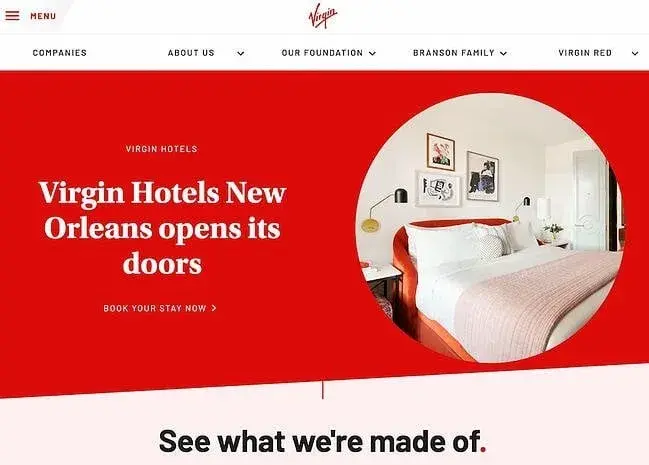
When you book a flight on Virgin Atlantic, you’re on an omnichannel journey. You’ll start with a booking confirmation by email, then personalized app notifications preparing you for your flight. Important notifications about delays or cancellations come through multiple channels, offering customers the chance to rebook or get support through chat, voice, or app.
How does this work? Virgin consolidated five legacy CRMs into a single consolidated system that connects data points in the back end. The end result is a smooth travel experience for customers.
Why I Like This
- Since a flight is a one-time purchase, brands need to provide excellent service to prompt customers toward their next purchase. Virgin is a great example of integrating marketing and service.
3. Bank of America
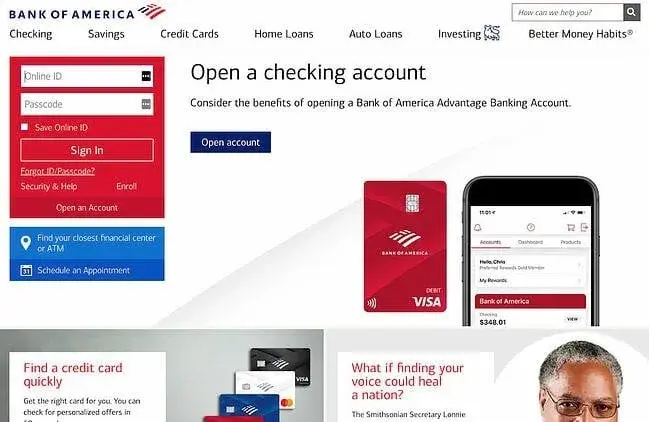
Bank of America takes its omnichannel development seriously. As one of the biggest brands in their industry, they‘re setting the standard for a dynamic experience, which — as of today — allows for everything from check depositing to bill reminders to budgeting to be handled by the company’s mobile and desktop apps.
Erica, Bank of America’s AI-powered chatbot, may prompt you to set and achieve goals like saving for a home. Erica also protects clients by double-checking potentially fraudulent transactions.
Why I Like This
- Allowing customers to complete tasks from multiple channels creates the ultimate convenience.
4. Oasis
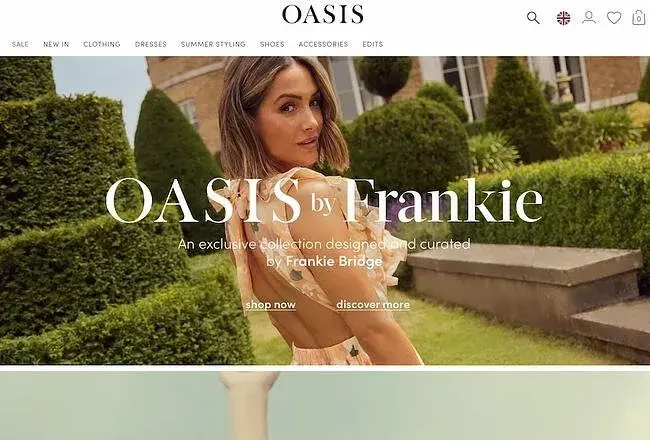
Oasis is a U.K. fashion retailer that's fusing its ecommerce site, mobile app, and brick-and-mortar stores into a simple shopping experience.
If you walk into one of its stores, you'll find sales associates armed with iPads that are available to give you on-the-spot, accurate, and up-to-date product information. The iPad also acts as a cash register, making it easy for associates to ring you up from anywhere in the store. And the cherry on top? If it appears that something is out of stock, the staff can instantly place an online order for you to have the item shipped directly to your home.
Why I Like This
- The Oasis app supplements all of the in-store and online shopping experiences to go the extra mile for customer service.
5. REI

Say that I’m checking that an item is in stock before taking a trip to a brick-and-mortar location. The website says it’s in stock, so I go to the store, but it’s not there. That’s not a great experience. REI handles this well through its many shopping touchpoints that give customers up-to-date and accurate product information at every turn.
“When we are doing research, we think about the experience that our customer might have— not just in-store, but also online,” shared Jennifer Lu, customer research lead at REI. We’ve done a lot of work with customer journeys to understand all of the touchpoints a customer must go through for an initiative.”
For example, they mapped out the full customer journey for Resupply, REI’s trade-in program. Based on their insights, they improved the Resupply website and other channel communications to match consumer wants, like seeing the trade-in value upfront.
Why I Like This
- All of the internal communication I’ve seen from REI prioritizes keeping customers happy, satisfied, and excited to return to the store again and again.
6. Starbucks
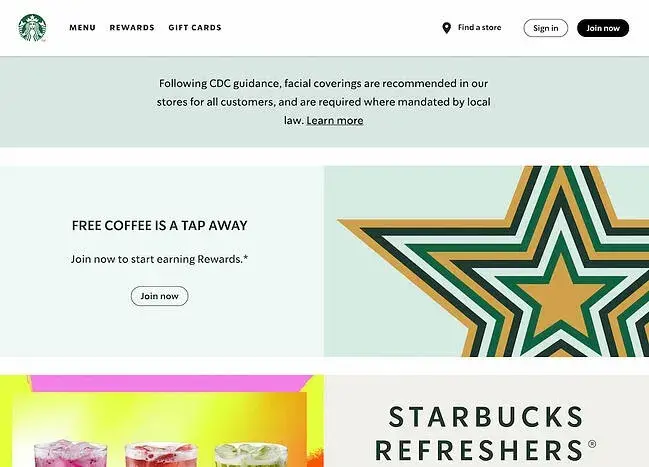
A quick look at the Starbucks app reveals why many consider it one of the top omnichannel experiences out there.
First, you get a free rewards card to use whenever you make a purchase. But, unlike traditional customer loyalty programs, Starbucks makes it possible to check and reload your card via phone, website, in-store, or on the app. Any change to the card or your profile are updated across all channels, in real-time.
Standing in line to get a coffee and realize you don‘t have enough on your balance? Reload it, and it’ll be updated by the time you swipe your card. Starbucks also uses AI to enhance the customer experience through personalized recommendations, weather-based messaging, and more.
Why I Like This
- A customer’s mobile experience is more important than ever, so having a great app goes a long way.
7. Chipotle
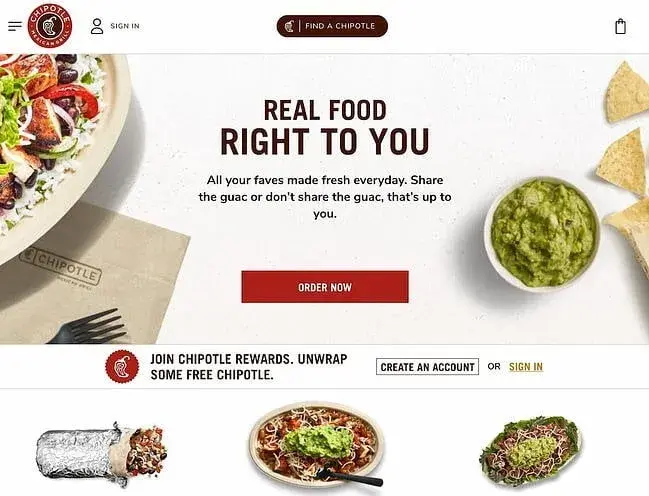
Have you ever ordered something online, only to find that the restaurant hadn't prepared your purchase by the time you arrived? I hate when that happens.
Chipotle seeks to eradicate that frustration with its online experience and mobile app that allow you to place an order wherever you are to be ready by the time you arrive to pick it up. And, if you sign up for an account, you can save your favorite orders for an even quicker and seamless experience.
Why I Like This
- With its easy-to-navigate tools that offer on-the-go ordering, Chipotle does a great job at delivering an omnichannel experience that makes the customer’s life as easy as possible.
8. Timberland

Timberland creates a connective customer experience in its brick-and-mortar locations by utilizing near-field communication technology, which is the software responsible for data transfer tools like Apple Pay and Android Pay. This tech allows users to tap their mobile devices against a chip that wirelessly transfers information between the two devices.
Timberland makes unique use of this tech and gives in-store shoppers access to a tablet to press against products to learn more about them. Instead of seeking out a store clerk, customers can get information independently and ask for help when needed rather than as a first resort. Shoppers also get product recommendations as they shop, and the personalization software learns their interests.
Why I Like This
- The individualized experience for the customer highlights products that may be often overlooked.
9. Orvis
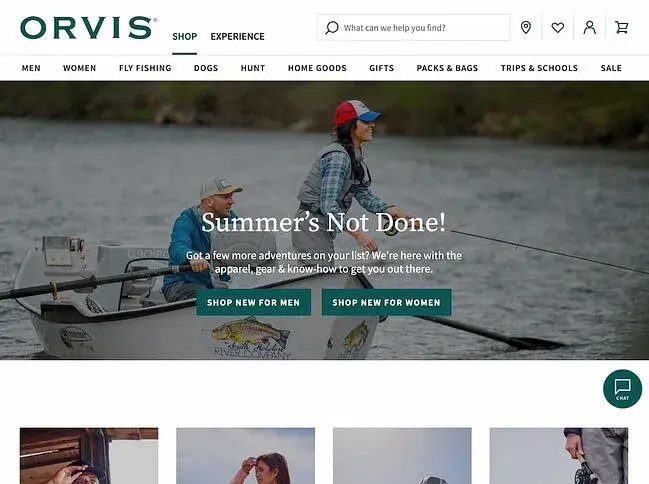
Orvis is a sporting goods retailer that has won awards for its omnichannel strategy. How, you might ask? Orvis understands its target audience and knows the most effective ways to communicate with them.
While its original channel was a mail-order catalog launched in 1856, Orvis now communicates with customers through mobile, web, and social media.
After finding that in-person experiences were still important to its older, outdoors-oriented customers, Orvis embraced a hybrid approach by equipping store associates with tablets. Now, associates leverage pre-installed CRM and ecommerce tools to order out-of-stock products and charge customers for both online and in-store purchases.
This improves customer experience and records customer information, shopping habits, and purchase history for better insights.
Why I Like This
- Being able to simultaneously provide a great experience to customers and essential data to a marketing team is dually beneficial.
10. Sephora
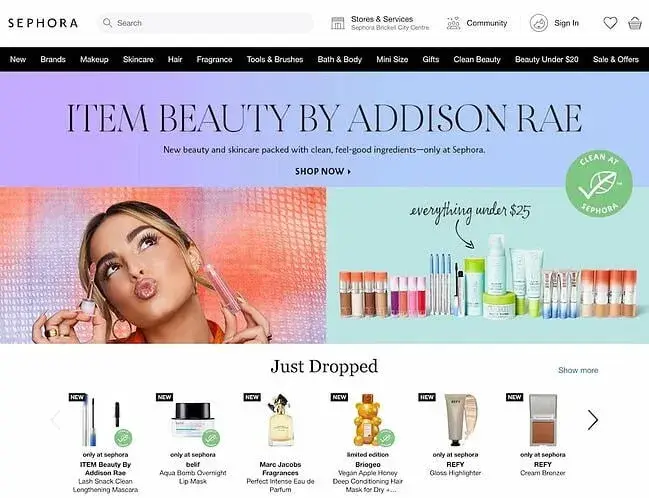
Beauty giant Sephora creates an omnichannel experience that connects its shoppers' online purchases to each in-store visit. Customers can use in-store tables and access their “Beauty Bag” (basket) while shopping to look up item details and even virtually try on products using the digital software.
While email and calls remain an option for customer service, most Sephora customers choose the chat function when they need support.
Why I Like This
- By integrating its Beauty Bag feature with its in-store communication channel, Sephora pushes customers to make purchases by giving them easy access to products they’ve already shown interest in and considered purchasing.
11. Amazon
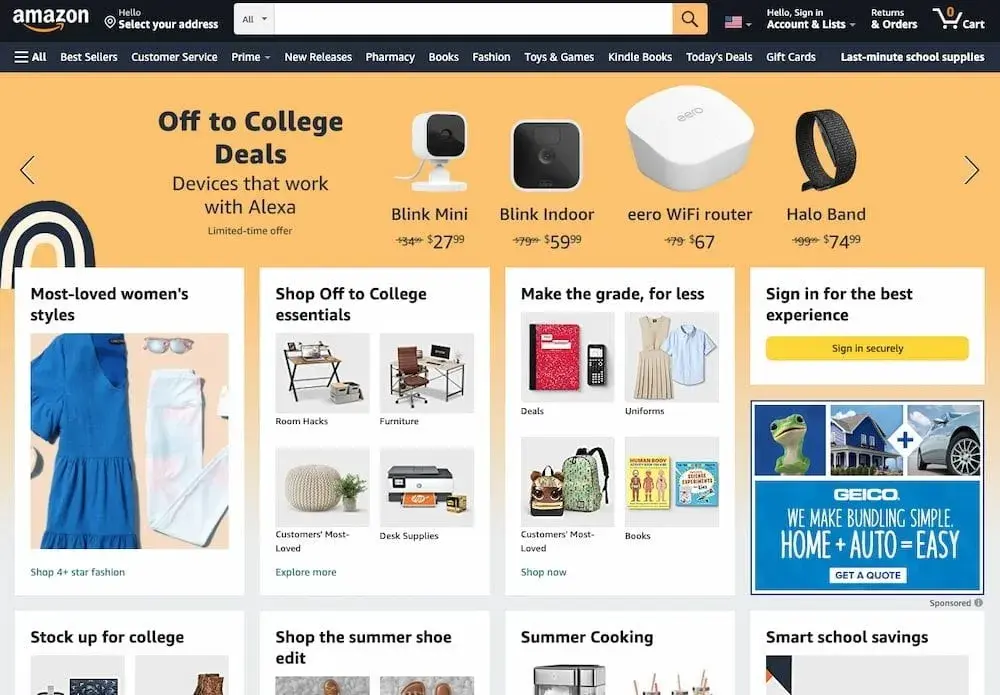
Amazon founder Jeff Bezos once declared, “If there‘s one thing Amazon.com is about, it’s obsessive attention to the customer experience, end-to-end.”
Twenty-five years later, Amazon is the king of the omnichannel experience in the consumer retail space. Not only does it have an app and website that automatically syncs users’ carts when they are signed in, but it also offers a support experience that gives customers the option to choose whatever method they’re most comfortable with.
Through Amazon Go and Whole Foods, users can even integrate the app with their in-store experiences.
Why I Like This
- The omnichannel experience that Prime members receive gives them access to the benefits of membership on any device, platform, or place.
12. Barnes & Noble
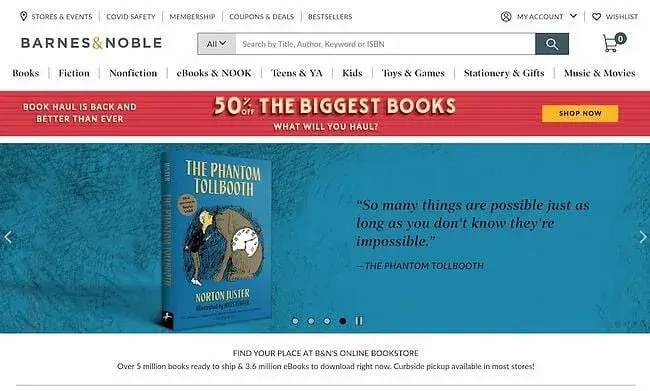
Brick-and-mortar bookstores might be considered a thing of the past, but Barnes & Noble wins at giving their members and customers the traditional brick-and-mortar experience while staying agile in the marketplace. Whether you access its offerings through the Nook app, the mobile website, the desktop website, or the physical store, you’ll have similar, if not identical, experiences.
Channel integration includes order and inventory synchronization, click-and-collect service, and unified shopping carts, letting customers start an order online — then finish it in-store.
Why I Like This
- Having a mobile experience in addition to a place for customers to read their books creates a personal connection.
13. Google Chrome

Google is another champion for omnichannel experiences, and a particular example is its browser, Google Chrome. When users are logged in, their history and activity are automatically synced into every device. Users can even access tabs on their phones that they left open on their laptops.
This synchronization gives users a seamless experience regardless of the device they use to access Chrome. The result? Google Chrome holds the majority market share — 64.9% of web wanderers— in the internet browser industry. That shows just how important it is to offer an omnichannel experience not just through your marketing, sales, and service efforts, but through your product, too.
Why I Like This
- Google’s wide reach means that it can create a smooth, harmonious omnichannel experience for customers.
14. Spotify

Spotify is another great example of offering an omnichannel experience at a product level. It has a web app, a desktop app, and a mobile app, and activity is synced among all channels when you have them open at the same time. For example, if I'm listening on my phone but also using my computer, I can skip to the next stop in my queue from my desktop.
Why I Like This
- Spotify’s availability on most platforms and devices provides an omnichannel experience with very little variation in the actual user experience.
15. Apple
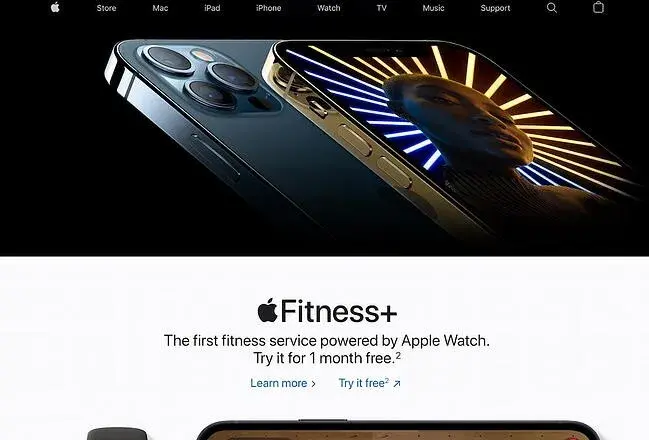
Apple takes the omnichannel experience to the next level by offering devices that seamlessly communicate with each other through user’s iCloud accounts. Messages, photos, and connected devices all share the same info regardless of device being used. And, if someone purchases a new device, they can sign in using their iCloud account and all pertinent information, data, and settings are downloaded to the new device.
To reach this sort of interconnectivity between your company’s products and services, you can emulate Apple’s omnichannel experience through a CRM like HubSpot that stores every single interaction your customer has with you. Whether they use email, phone, or chat to speak with your team, the customer should have a frictionless experience, which is what building an omnichannel strategy is all about.
Why I Like This
- The connectivity between devices, accounts, and platforms makes it easy for customers to transition between all of them.
Omnichannel Marketing Platforms
Without the right platform, omnichannel marketing can easily fall short.
Spreading your resources across each platform must be done efficiently to be truly beneficial for your business. Platforms that are created for omnichannel marketing will help your business seamlessly operate across channels. The three below were designed for exactly that.
1. HubSpot CRM
HubSpot’s complete CRM platform is an all-in-one marketing automation tool. Whether your focus is to grow sales, increase leads, or improve customer service, it’s functional, flexible, and able to meet your needs. It comprises six hubs: Marketing Hub, Service Hub, CMS Hub, Sales Hub, Operations Hub, and Commerce Hub, each packed with powerful features to help you grow your business.
2. Shopify
Shopify is a high-quality ecommerce tool that you can use as an omnichannel marketing tool. You can sell products and create social media campaigns, and it also helps you stay on top of engagement throughout every stage of the customer acquisition funnel.
All in all, this tool can help you develop personalized experiences for your audience, optimize your sales to generate more revenue, and measure the impact of your marketing campaigns.
3. ActiveCampaign
ActiveCampaign combines automation, marketing, and CRM tools to help you create quality experiences for your audience. Its key features are segmented by customer touchpoints (reach, nurture, convert & grow, and ecommerce), and the platform is “stackable,” meaning you can mix and match different tools, applications, and channels to create the omnichannel marketing tool your business needs.
Omnichannel Retail
Omnichannel retail refers to the method of putting your products and services up for sale on all channels and platforms to increase reach, reduce friction, and boost sales. An omnichannel retail experience can include all the channels you have, including brick-and-mortar stores, app-based options, and online platforms. For example, if I own a clothing brand, my omnichannel retail strategy is to sell products on my website, app, Instagram Shops, Amazon, and physical locations.
Omnichannel retail is most relevant to retail-based business-to-consumer (B2C) industries like consumer goods, clothing, and food and beverage. Business-to-business (B2B) companies can simulate an omnichannel environment by offering prospects demos or scheduling consultations across multiple channels and platforms.
Payment links are another way to connect your retail experience. Payment tools like HubSpot Payments let you embed payment links into emails, quotes, invoices, text messages, or even chat windows.
Regardless of your business type, though, omnichannel retail is most powerful when paired with an omnichannel marketing strategy. When you align your messaging, goals, objectives, and design across every channel and device, you’re offering a seamless and cohesive experience to prospects/customers, and making sure you show up on the different channels they may prefer to use.
Need a starting point? Start with our marketing plan template and marketing campaign template.
Creating an Omnichannel Experience is the Key to Future Success
Every company must develop its own unique omnichannel experience infrastructure, and you'll need to work closely with several departments in your company to develop this strong strategy.
While building your program, look to the following stakeholders:
- Product
- Marketing
- Sales
- Customer Support
- Customer Success
Once everyone understands the goals and objectives of your omnichannel initiative, you can start planning your transition to this model. Including these departments early on will make it easier as you try to shift into an omnichannel way of doing things — it's less of a headache down the road when you get people excited in the beginning.
The scale of some of the integrations I described above may make an omnichannel customer experience feel out of reach for smaller companies, but there’s nothing wrong with starting small with a few channels and expanding as you grow. Ultimately, regardless of how many channels you start with, your strategy should consist of a strategic plan to build a coherent and aligned experience across multiple platforms.
Amidst all this planning, don’t lose sight of the end goal. The purpose of all that technology and planning is to create a delightful experience and give customers a reason to stick around.
“Omnichannel is not just about having multiple ways to communicate; it's about ensuring those ways are connected and provide a seamless experience,” advises Hyken.
Editor's note: This post was originally published in December 2017 and has been updated for comprehensiveness.
Customer Experience

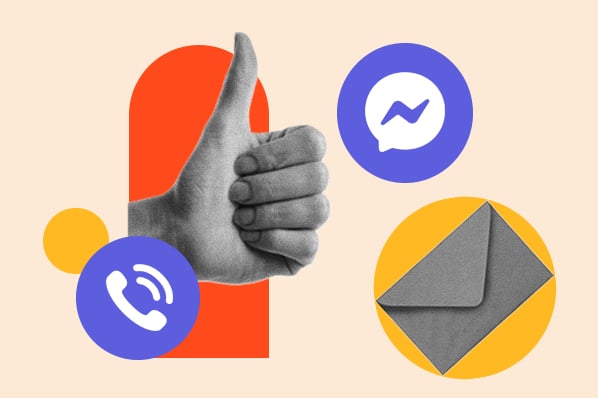
.webp)

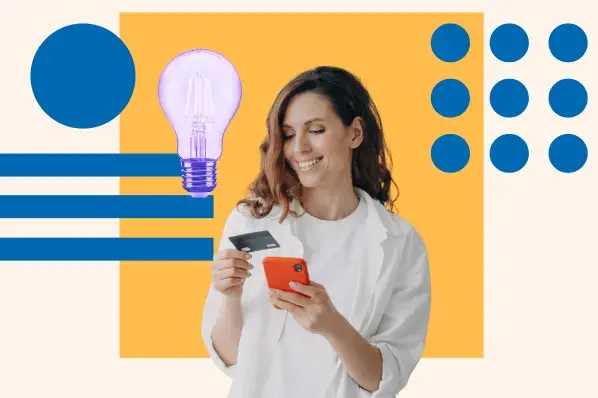
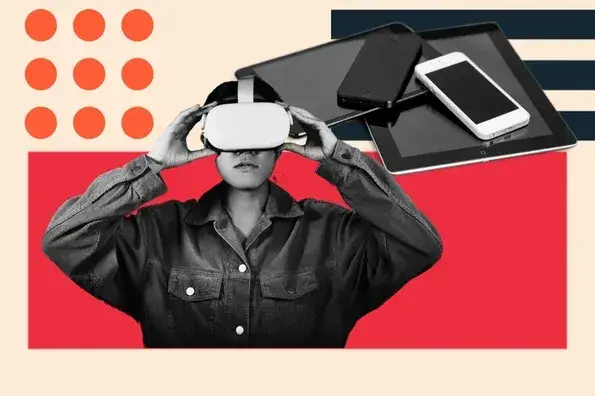
![Is The Customer Always Right? [What It Means + Why It Matters]](https://53.fs1.hubspotusercontent-na1.net/hubfs/53/customer-is-always-right-origin-1-20250202-6448090.webp)
